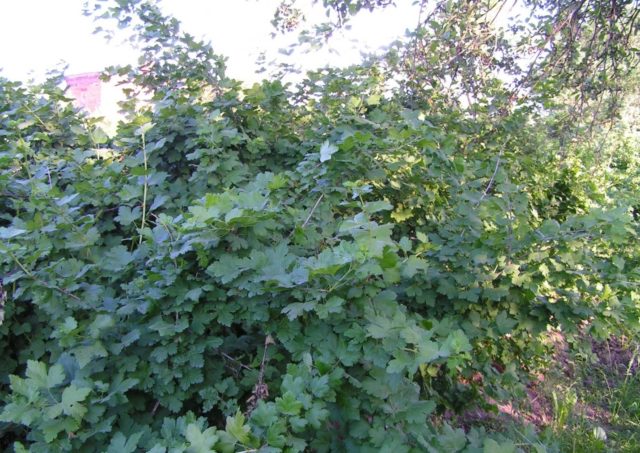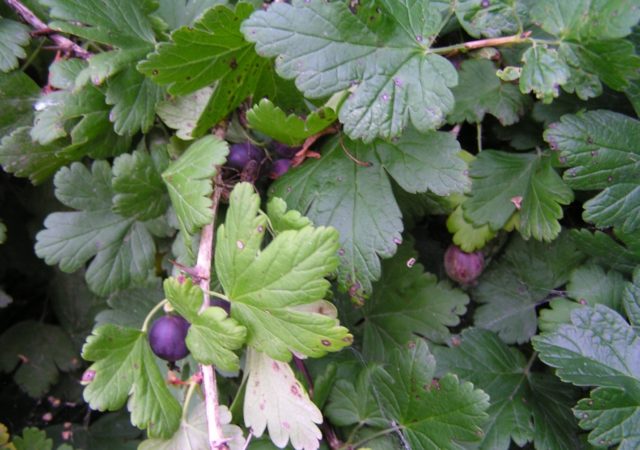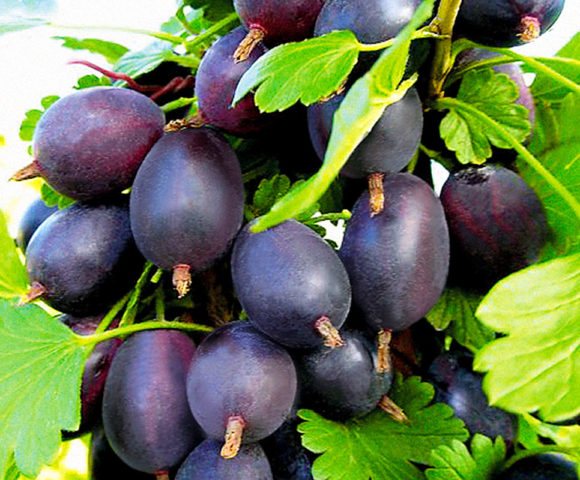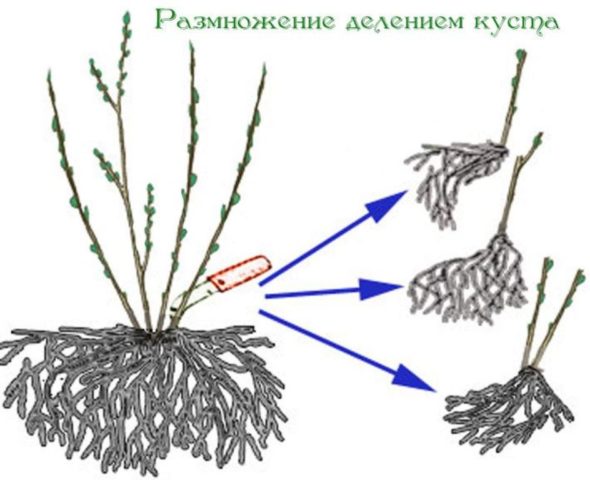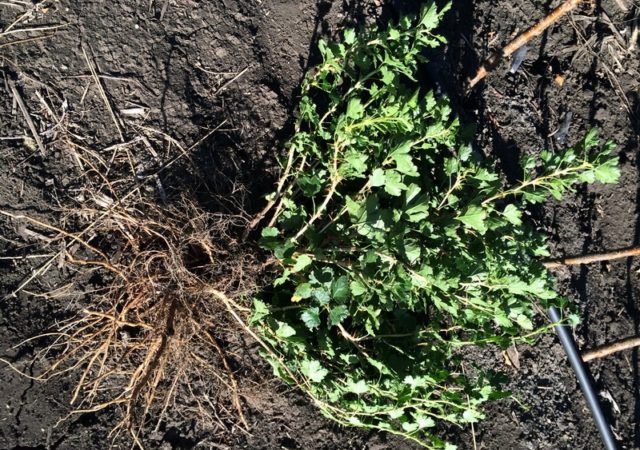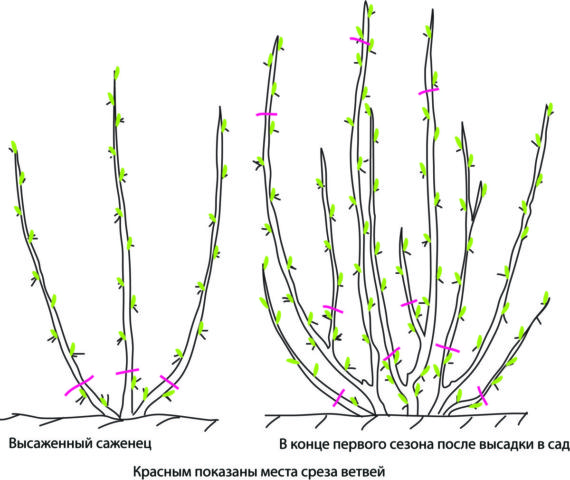Content
In the Russian Institute of the Gardener under the leadership of Ivan Michurin in the last century, scientists have received a new variety - this is the Black Negus gooseberry. The aim of the study was to breed a crop resistant to external factors and pests with high palatability.
Description of gooseberry Black Negus
The shrub is very powerful, reaches a height of 1.5-2 m, but by 10 years of age it can grow even higher. The plant is spreading, up to 3 m wide. According to the description of the variety and the photo, the Black Negus gooseberry has strong and very strong shoots of an arched shape. The branches grow upward, slightly deviate to the side. On the shoots in the internodes there are thorns, reaching a length of 2 cm, and slightly curved downward. There are single, double or triple thorns on the plant.
According to the description and photo, the Black Negus gooseberry is the owner of large three-lobed and five-lobed leaf plates with a light fluff of a bright green hue and rounded teeth. Their upper surface is dimmer, with slight wrinkles. The petiole of the leaves is thin, long and uncolored. One or two flowers form an inflorescence.
The berries of the Black Negus gooseberry are distinguished by an elongated shape, similar to a pear. They are small in size, each weighing 2-2.5 g. Young berries have a tender, medium-thick skin without pubescence, a green tint. A bluish waxy bloom is visible on the fruits.
A fully ripe berry of the variety has a dark purple, closer to black, color. Vein formation in ripe fruits is not visible. The taste of Black Negus gooseberry is sweet and sour, similar to grape. The aroma of the berry is strongly pronounced, specific. After ripening, gooseberry fruits remain on the branches for a long time, without crumbling, do not crack during bad weather and heat.
The recommended region for cultivation is the middle zone of Russia.
Drought resistance, frost resistance
According to the description of the variety, the Negus gooseberry tolerates low temperatures well in winter and spring. The plant can safely withstand frosts down to -25 ° C. After research carried out in 1964-1966 in the Non-Chernozem zone, the culture was recognized as one of the winter-hardy, which makes it possible to grow gooseberries not only in central Russia, but also in regions with a colder climate.
The plant is drought-resistant, but neglect of the rules of agricultural technology negatively affects the yield of the variety.
Fruiting, productivity
With proper planting and care, gooseberries can begin to bear fruit in the second year after the seedling is transferred to the ground. The ripening time of the berries is average: harvesting is possible from the last week of July or in August.
The fruits are located from the beginning to the end of the branch, they are not prone to premature shedding and cracking. Up to 7-8 kg of berries can be harvested from one adult shrub.
The harvested crop has a high transportability: up to 25 days. The berries are marketable. They are also used in cooking: they make preserves and jams from them. The variety is well suited for wine and compotes.
Advantages and disadvantages
The variety has remained popular for several decades. When purchasing a seedling, gardeners are guided by the benefits of the Black Negus gooseberry:
- high taste, estimated at 4.7 points, which expands the area of their application in cooking;
- the presence of medicinal properties in the plant and a large amount of useful substances in it;
- high frost resistance;
- regular fruiting for 15-18 years;
- the ability of berries to retain their properties and appearance during long-term transportation;
- resistance to powdery mildew and various diseases;
- high yield of the variety.
The main disadvantage of the Black Negus gooseberry is the presence of sharp thorns that interfere with harvesting and caring for the plant. But gardeners use this feature to their advantage, planting a shrub as a hedge along the fence.
Breeding features
The gooseberry variety Black Negus reproduces like other black-fruited representatives of the culture using standard methods:
- Layers... One of the young shoots is bent to the ground and sprinkled with soil. After a while, the root system is formed on the branch in the region of bud formation. This method is considered to be the most effective.
- Shoots... For reproduction, branches close to the base of the plant are cut off, which are then rooted. This cultivation method is suitable for shrubs no more than 9 years old.
- Branches... A well-formed branch is determined in a shrub, then it is separated from the mother bush with a part of the root system, then transplanted to another place.
- By dividing... This method of reproduction allows you to rejuvenate the shrub. It is dug up and divided into two parts. The most viable part is transferred to a new location.
The choice of reproduction method depends on the shrub: it is preferable to divide the old bushes, shoots and layering are safely separated from young plants, which take root well, subject to the rules of agricultural technology.
Planting and leaving
The Negus gooseberry variety loves the sun's rays, so it is recommended to allocate a place with good lighting or in partial shade on the plot. It is necessary to place the shrub on a hillock or flat area. The variety planted in the lowlands does not grow well. With an excess of moisture, the plant infects root rot
The variety is undemanding to the composition of the soil, but the highest yields are achieved when the plant is grown on loamy or sandy soils. Gooseberries grow well on neutral soils.
14 days before planting, the earth is dug up, all weeds and debris are removed. During work, it is necessary to add humus or compost to the soil. Potash and nitrogen fertilizers are used as fertilizers.
Before planting a gooseberry seedling Black Negus, they dig a hole 0.5 m deep and wide.If it is necessary to plant several bushes between the plants, it is necessary to retreat 1.5 m.
Gooseberry seedling Black Negus must have a strong root system. 24 hours before planting, it is soaked in an aqueous solution with the addition of organic fertilizers. To do this, add 4 tablespoons of Sodium Humate to 5 liters of water. Alternatively, it is possible to treat the plant with a solution of Zircon (0.25 ml of substance per 1000 ml of water).
It is recommended to place a seedling of the Black Negus variety in the pit directly or with a slight slope. All roots should be straightened, the root collar deepened by 5-6 cm.
It is necessary to fill the seedling with earth in parts, compact each layer and water it with water. At the end of the procedure, it is recommended to mulch the plant with a mixture of peat, sand and humus. This will avoid rapid evaporation of moisture and prevent the formation of a crust on the surface of the well. In winter, mulching serves to prevent freezing of the root system. All shoots must be cut, leaving branches up to 10 cm tall with 5-6 buds.
Growing rules
For the Black Negus gooseberry variety, it is important to adhere to the rules of agricultural technology. Neglecting the rules of care negatively affects the yield of the plant and its growth.
The variety is picky about watering: in dry months, it is necessary to moisten the soil 3-5 times.It is important to provide the shrub with sufficient water during flowering and ovary formation.
When fertilizing the soil during planting, there is no need to feed the shrub for the next three years. In subsequent years, in the spring and autumn, it is recommended to add compost, humus and nitrogen fertilizing to the soil around the Black Negus gooseberry variety.
As an organic fertilizer, mullein infusion diluted in water 1: 5 has a beneficial effect on the culture; as a replacement, it is possible to use bird droppings diluted in a ratio of 1:12 to water.
Photos and reviews of the Black Negus gooseberry confirm that the variety is prone to thickening, which requires annual pruning. Neglect of this procedure leads to a decrease in yield, ripe berries are difficult to pick from the branches.
The best time for pruning is autumn, when sap flow slows down. In the spring, the plant dissolves its foliage very early, therefore, it is not recommended to remove shoots after the snow melts.
All weak branches, up to 20 cm in length, are pruned. Dry, broken and diseased shoots are also cut with pruning shears. On the shrub of the Black Negus gooseberry variety, only strong branches, up to 50 cm in length, should remain.
In order to make the Black Negus gooseberry shrub more compact, it is recommended to build wooden supports for it.
As the plant matures, the aging phase begins, therefore, 6-8-year-old shoots are removed during pruning. The shrub will instead form new branches from the root collar. In a 4-6-year-old bush, the total number of shoots, including lateral ones, does not exceed 30 pieces.
Due to its frost resistance, the variety does not need to be covered for the winter. Be sure to shed gooseberries thoroughly in the fall, mulch the soil around the bush.
Pests and diseases
Despite the presence of good immunity of the Black Negus gooseberry variety, regular preventive measures are recommended. For this, the bush is treated with a solution from parasites and fungi. To prepare it, add 1/3 tsp to 10 liters of boiling water. boric acid and a pinch of potassium permanganate, mix everything thoroughly. It is convenient to apply the product using a spray bottle.
Conclusion
Black Negus gooseberry is a variety known not only for its unusual berries, but also for its immunity to powdery mildew. The culture is unpretentious in care, tolerates low temperatures well and bears fruit for 16-18 years, which is an undoubted advantage of this variety.
Testimonials
